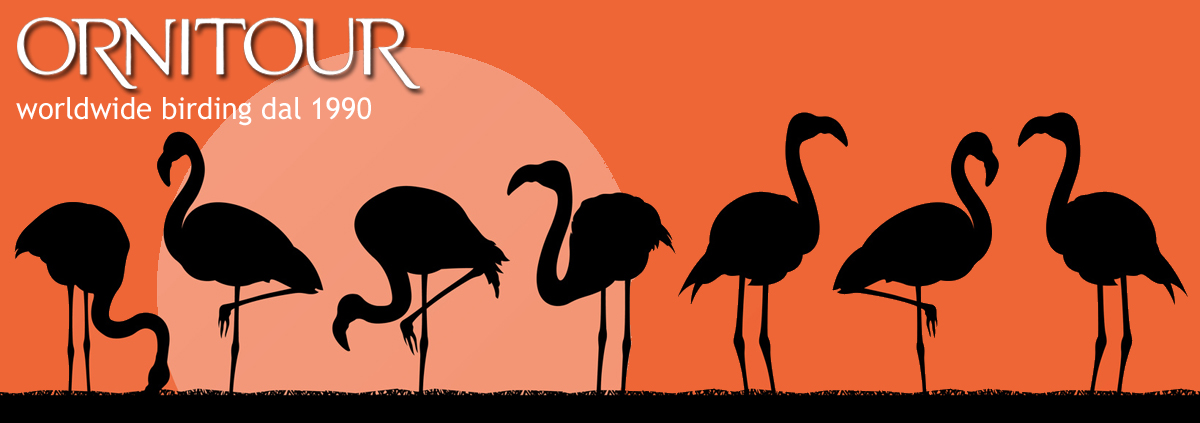Chi segue Ornitour.it da tempo, conosce la predilezione dei curatori del sito per la settima arte: citazioni, metafore e financo un quiz ornitocinematografico costellano le varie pagine del sito. Così ci è sembrato doveroso riportare una notizia apparsa su BirdLife International riguardante l'impatto che una delle più famose saghe cinematografiche statunitensi potrebbe aver avuto sull'avifauna europea. Immaginatevi un'isola, un'isolotto, poco più di un grosso masso, trapuntata da fazzoletti di prateria che si insinuano tra i crepacci rocciosi, realizzando un paesaggio di fiabesca bellezza: siamo a Skelling Michael, l'isolotto più grande delle due Isole Skellig, situato a circa 17 km dalle coste del Kerry, Irlanda. Skelling Michael è disabitata dagli umani, ma è casa a migliaia di uccelli marini, Uccelli delle tempeste europei, Pulcinella di mare, Berte di Man, Gabbiani tridattili. I censimenti ornitologici più recenti (Seabird 2000, risalenti ormai a 15 anni fa) rendono conto di 9.994 coppie nidificanti di Uccelli delle tempeste europei (10% della popolazione irlandese) e 738 coppie di Berte di Man; l'inaccessibilità dell'isola, insieme al perfetto habitat per la nidificazione hanno portato alla formazione di colonie tra le più grandi del mondo. La fama di Skelling Michael è dovuta soprattutto alla presenza sulla sua sommità di uno straordinario quanto poco accessibile monastero di origine cristiana costruito nel 588 e divenuto patrimonio dell'umanità protetto dall'UNESCO nel 1996.
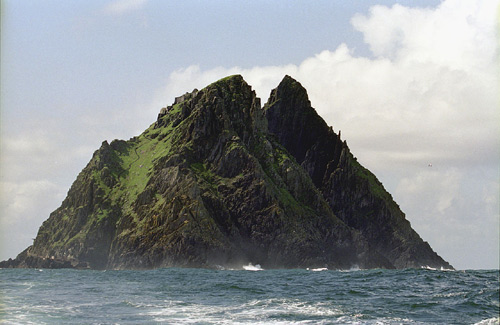 |
| L'isolotto di Skelling Michael, a poche miglia dall'angolo sud-occidentale dell'Irlanda (© Jerzy Strzelecki, CC BY-SA 3.0). Il nome deriva dal gaelico Sceilig Mhichíl, che significa "la roccia di Michele". E' un'importantissima area di nidificazione per cinque specie di uccelli marini: Berta di Man, Gazza marina, Pulcinella di mare, Uria nera, Gabbiano tridattilo |
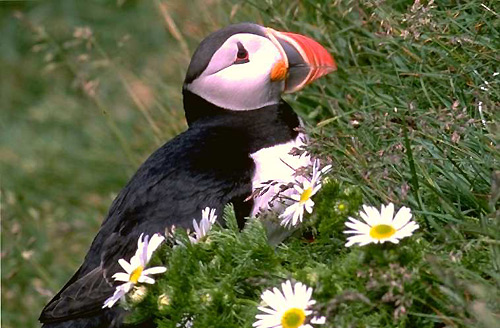 |
| Un simpatico e coloratissimo Pulcinella di mare (© Justbirds) |
Leggi l'intero articolo su BirdLife International
Chiudi il box
Si è tenuto in 41 paesi, il 3 e 4 ottobre scorsi, l’edizione 2015 di Euro Birdwatch. Più di 1.000 eventi, da sessioni di inanellamento a camminate ornitologiche a “educational workshops”, sono stati organizzati dai partner nazionali di BirdLife International, dall’Austria all’Uzbekistan. Questi eventi sono stati pensati, ideati e disegnati per birdwatcher e ornitologi, ma anche per un pubblico più vasto. La prima edizione di Euro Birdwatch risale al 1993 e da allora più di un milione di persone hanno partecipato a più di 36.000 eventi, registrando più di 60 milioni di uccelli colti lungo la via della migrazione verso sud. La maggior parte delle nazioni coinvolte ha organizzato censimenti migratori, sia in stazioni preesistenti gestite da birdwatcher esperti, che attraverso escursioni a una o più IBA (Important Bird Areas). I dati sono stati trasmessi all’European Centre (quest’anno era il Vogelbescherming Nederland, BirdLife nei Paesi Bassi). Ma Euro Birdwatch non è solamente una mera conta di uccelli. Per sopravvivere, gli uccelli migratori non hanno bisogno solo di buone condizioni riproduttive, nelle fredde aree nordeuropee, ma anche di sicure aree di stop-over sulle loro rotte migratorie e di ottimali condizioni nei quartieri di svernamento africani o dell’Europa meridionale. L’obiettivo di Euro Birdwatch è mostrare al pubblico generale la meraviglia della migrazione degli uccelli e portare la sua attenzione sui pericoli che milioni di uccelli incontrano sul loro volo verso sud. Studi e monitoraggi sul territorio di BirdLife International hanno dimostrato che ogni anno 25 milioni di uccelli sono uccisi illegalmente nei paesi mediterranei durante le migrazioni primaverile e autunnale. Lo Storno comune, il Fringuello comune e la Folaga comune sono state le specie più comunemente osservate durante Euro Birdwatch 2015. Ma sono state anche registrate specie rare o rarissime, come il primo occhiocotto per il Lussemburgo.
Leggi i risultati di Euro Birdwatch 2015
Chiudi il box
All'alba del nuovo millennio le ricerche ornitologiche erano più fiorenti che mai. I nuovi studi genetici basati sul DNA si arricchivano di metodiche sempre più fini e anche le spedizioni sul campo si infittivano; il birdwatching aveva smesso di essere solo un hobby e stava contribuendo attivamente ad ottenere quella messe di informazioni che avrebbero portato ad una rivalutazione dello stato di minaccia di questa o quella specie (quasi sempre con risultati peggiorativi rispetto a quanto si conosceva della specie). Gli studi genetici hanno sorprendentemente avvicinato i falchi ai pappagalli e i sopralluoghi nei musei hanno identificato nuove specie. Le spedizioni nelle profondità delle jungle sudamericane e asiatiche hanno fatto saltar fuori inattesi tapaculo e inimmaginati garruli. Le nazioni con il maggior numero di nuove specie sono Brasile, Colombia, Perù e Indonesia. Di seguito una lista, divisa per anno, dal 2000 a quello corrente, di nuove specie e split. Per qualche specie, di particolare interesse, aggiungiamo qualche breve notizia.
| 2000 | ||
| Foothill Elaenia | Myiopagis olallai | |
| Caatinga Antwren | Herpsilochmus sellowi | |
| Taiwan Bush-Warbler |
Locustella alishanensis |
|
| (Wallace's) Scarlet-banded Barbet |
Capito wallacei |
|
| Gunnison Sage-Grouse | Centrocercus minimus | Questa specie passò inosservata fino agli anni '90 a causa della grande somiglianza con Centrocercus urophasianus, e fu riconosciuta ufficialmente solo nel 2000: la prima nuova specie descritta negli Stati Uniti d'America dal 19° secolo! |
| Gray-crested Cacholote |
Pseudoseisura unirufa | Specie splittata da Pseudoseisura cristata, Caatinga Cacholote |
| 2001 | ||
| Bukidnon Woodcock |
Scolopax bukidnonensis |
|
| Mekong Wagtail |
Motacilla samveasnae |
Scoperta solo nel 2001, questa specie onora, nel nome specifico l'ornitologo cambogiano Sam Veasna |
| Chestnut-eared Laughingthrush |
Garrulax konkakinhensis |
Per Clements Ianthocincla konkakinhensis |
| Chestnut-capped Piha |
Lipaugus weberi |
|
| Chapada Flycatcher |
Suiriri islerorum |
|
| Mishana Tyrannulet |
Zimmerius villarejoi |
|
| Lulu's Tody-Flycatcher | Poecilotriccus luluae | Per Clements Johnson's Tody-Flycatcher |
| 2002 | ||
| Bald Parrot |
Pyrilia aurantiocephala |
Fino al 2002 si pensava che gli individui di questa specie fossero giovani di Pappagallo vulturino Pyrilia vulturina, la cui testa nuda è nera, mentre la specie in oggetto ha la testa color arancio |
| Cryptic Forest-Falcon |
Micrastur mintoni |
|
| Kimberley Pipit |
Anthus pseudosimilis |
Non riconosciuta da Clements, ma presente nella lista HBW e IOC |
| Little Sumba Boobook |
Ninox sumbaensis |
|
| Madeira Parakeet |
Pyrrhura snethlageae |
Non riconosciuta da Clements, per il quale è ancora sottospecie di Pyrrhura amazonum |
| Wavy-breasted Parakeet |
Pyrrhura peruviana |
Non riconosciuta da Clements, per il quale è ancora sottospecie di Pyrrhura amazonum |
| Carajas Woodcreeper | Xiphocolaptes carajaensis | Non riconosciuta da Clements, per il quale è ancora sottospecie di Xiphocolaptes promeropirhynchus |
| Lafresnaye's Woodcreeper |
Xiphorhynchus guttatoides |
split da Xiphorhynchus guttatus, ma non per Clements che mantiene il taxon ancora come sottospecie |
| Elegant Woodcreeper |
Xiphorhynchus elegans |
split |
| Tschudi's Woodcreeper | Xiphorhynchus chunchotambo | split da Xiphorhynchus ocellatus, ma non per Clements che mantiene il taxon ancora come sottospecie |
| 2003 |
||
| Pernambuco Pygmy-Owl |
Glaucidium mooreorum |
|
| Carrizal Seedeater |
Amaurospiza carrizalensis |
|
| Munchique Wood-Wren |
Henicorhina negreti |
|
| Okarito Brown Kiwi | Apteryx rowi | |
| 2004 | ||
| Serendib Scops-Owl |
Otus thilohoffmanni |
|
| Togian Boobook |
Ninox burhani |
|
| Rubeho Akalat |
Sheppardia aurantiithorax | |
| Acre Antshrike |
Thamnophilus divisorius |
|
| Calayan Rail |
Gallirallus calayanensis |
|
| Mees's Nightjar | Caprimulgus meesi |
|
| 2005 | ||
| Sulphur-breasted Parakeet |
Aratinga pintoi |
nel 2009 è stato dimostrato che Aratinga maculata e Aratinga pintoi rappresentano lo stesso taxon |
| Magdalena Tapaculo |
Scytalopus rodriguezi |
|
| Stiles's Tapaculo |
Scytalopus stilesi |
|
| Iquitos Gnatcatcher |
Polioptila clementsi |
|
| Naung Mung Scimitar-Babbler |
Napothera naungmungensis |
split da Napothera danjoui, ma non per Clements che mantiene il taxon ancora come sottospecie |
| Planalto Tapaculo |
Scytalopus pachecoi |
|
| Rubeho Partridge | Xenoperdix obscurata | split da Xenoperdix udzungwensis, ma non per Clements che mantiene il taxon ancora come sottospecie |
| 2006 | ||
| Odedi |
Horomis haddeni |
|
| Camiguin Hanging-Parrot |
Loriculus camiguinensis |
|
| Hocking's Conure |
Aratinga hockingi |
Clements non riconosce questo taxon |
| Bugun Liocichla |
Liocichla bugunorum |
|
| 2007 | ||
| Sincorá antwren |
Formicivora grantsaui |
|
| Gorgeted Puffleg |
Eriocnemis isabellae |
|
| Rufous Twistwing |
Cnipodectes superrufus |
|
| Antioquia Brush-Finch |
Atlapetes blancae |
|
| Diamantina Tapaculo | Scytalopus diamantinensis | |
| Solomon Islands Frogmouth |
Rigidipenna inexpectata | split da Podargus ocellatus |
| 2008 | ||
| Nonggang Babbler | Stachyris nonggangensis |
|
| Olive-backed Forest Robin |
Stiphrornis pyrrholaemus |
split da Stiphrornis erythrothorax, ma non per Clements che mantiene il taxon ancora come sottospecie |
| Monteiro's Storm-Petrel |
Oceanodroma monteiroi |
|
| Vanikoro White-eye |
Zosterops gibbsi |
|
| Togian white-eye |
Zosterops somadikartai |
|
| Amazon red-fronted Parakeet | Pyrrhura parvifrons | split da Pyrrhura roseifrons, ma non per Clements che mantiene il taxon ancora come sottospecie |
| 2009 | ||
| Bare-faced Bulbul |
Pycnonotus hualon |
|
| Rubeho Warbler |
Scepomycter rubehoensis |
split da Scepomycter winifredae, ma non per Clements che mantiene il taxon ancora come sottospecie |
| South Hills Crossbill |
Loxia sinesciurus |
split da Loxia curvirostra, ma non per Clements che mantiene il taxon ancora come sottospecie. Questo gruppo monotipico del Crociere comune, ha un areale ristretto alle South Hills e Albion Mountains dell'Idaho centro-merisionale. Se accettata, sarebbe la seconda nuova specie statunitense del terzo millennio |
| Río Orinoco Spinetail |
Synallaxis beverlyae |
|
| Black-capped Woodnymph | Thalurania nigricapilla | specie non riconosciuta da Clements |
| Vanuatu Petrel |
Pterodroma occulta |
|
| 2010 | ||
| Limestone Leaf-Warbler |
Phylloscopus calciatilis |
|
| Urrao Antpitta |
Grallaria urraoensis |
|
| Socotra Buzzard |
Buteo socotraensis |
Una delle due nuove specie del Paleartico Occidentale |
| Willard's Sooty Boubou |
Laniarius willardi |
|
| Rock Tapaculo | Scytalopus petrophilus | |
| 2011 | ||
| Tsingy Wood-Rail |
Canirallus beankaensis |
|
| Bryan's Shearwater |
Puffinus bryani |
|
| Várzea Thrush | Turdus sanchezorum | |
| 2012 | ||
| Alta Floresta Antpitta |
Hylopezus whittakeri | |
| Antioquia Wren |
Thryophilus sernai | |
| Sira Barbet |
Capito fitzpatricki | split da Capito wallacei, ma non per Clements che mantiene il taxon ancora come sottospecie |
| Bermuda Towhee |
Pipilo naufragus | Specie estinta, non inclusa tra quelle comunque citate da Clements. La descrizione scientifica fu fatta nel 2012 sulla base di resti pleistocenici e olocenici |
| Camiguin Hawk-Owl |
Ninox leventisi | |
| Cebu Hawk-Owl |
Ninox rumseyi | |
| 2013 | ||
| Rinjani Scops-Owl |
Otus jolandae |
|
| Pincoya Storm-Petrel |
Oceanites pincoyae |
|
| Delta Amacuro Softtail |
Thripophaga amacurensis |
|
| Bermuda Flicker |
Colaptes oceanicus | Un'altra specie estinta, nota da resti fossili ritrovati nell'isola di Bermuda e datanti al tardo Pleistocene e Olocene, anch'essa non citata da Clements |
| Sao Miguel Scops-Owl |
Otus frutuosoi | Non fosse che è estinta, questa sarebbe un'altra specie del Paleartico Occidentale. I suoi resti fossili sono stati trovati nell'isola di Sao Miguel nelle Azzorre. Come le precedenti specie estinte, anche questa non è citata da Clements |
| Seram Masked-Owl |
Tyto almae | |
| Junin Tapaculo |
Scytalopus gettyae | |
| Cambodian Tailorbird |
Orthotomus chaktomuk | Questa specie fu scoperta a Phnom Penh, la capitale della Cambogia, nel 2009, durante la campagna di sorveglianza avviata per l'influenza aviaria, La specie fu poi descritta nel 2012 |
| Tropeiro Seedeater | Sporophila beltoni | |
| Western Puffbird |
Nystalus obamai | Una nuova specie di puffino dell'Amazzonia occidentale. Il suo nome scientifico onora il presidente degli USA, Barack Obama |
| Xingu Woodcreeper |
Dendrocolaptes retentus | split da Dendrocolaptes certhia, ma non per Clements che mantiene il taxon ancora come sottospecie |
| Inambari Woodcreeper |
Lepidocolaptes fatimalimae | |
| Tupana Scythebill |
Campylorhamphus gyldenstolpei | split da Campylorhamphus procurvoides, ma non per Clements che mantiene il taxon ancora come sottospecie |
| Tapajós Scythebill |
Campylorhamphus cardosoi | split da Campylorhamphus procurvoides, ma non per Clements che mantiene il taxon ancora come sottospecie |
| Roosevelt Antwren |
Epinecrophylla dentei | Il nome sceintifico onora uno dei più famosi ornitologi brasiliani, Emilio Dente (1919-1995); il nome vernacolare si riferisce al Rio Roosevelt, type-locality che segna anche la barriera sud-orientale dell'areale |
| Bamboo Antwren |
Myrmotherula oreni | split da Myrmotherula iheringi, ma non per Clements che mantiene il taxon ancora come sottospecie |
| Predicted Antwren |
Herpsilochmus praedictus | I nomi, sia quello vernacolare che quello scientifico, si riferiscono al fatto che il taxon fu "predetto" essere una nuova specie sulla base delle sue peculiari vocalizzazioni, fatto che fu successivamente confermato dall'analisi del DNA mitocondriale |
| Aripuana Antwren |
Herpsilochmus stotzi | |
| Manicore Warbling-Antbird |
Hypocnemis rondoni | |
| Chico's Tyrannulet |
Zimmerius chicomendesi | |
| Acre Tody-Tyrant |
Hemitriccus cohnhafti | |
| Sucunduri Yellow-margined Flycatcher |
Tolmomyias sucunduri | split da Tolmomyias assimilis, ma non per Clements che mantiene il taxon ancora come sottospecie |
| Inambari Gnatcatcher |
Polioptila attenboroughi | split da Polioptila guianensis, ma non per Clements che mantiene il taxon ancora come sottospecie |
| Campina Jay |
Cyanocorax hafferi | split da Cyanocorax heilprini, ma non per Clements che mantiene il taxon ancora come sottospecie |
| Sierra Madre Ground-Warbler |
Robsonius thompsoni | |
| Guerrero Brush-Finch |
Arremon kuehnerii | specie non riconosciuta da Clements |
| Omani Owl |
Strix omanensis | Stessa specie di Hume's Owl. Trattiamo diffusamente il "problema" dell'Allocco di Hume qui |
| New Caledonia snipe | Coenocorypha neocaledonica | |
| 2014 |
||
| São Paulo Marsh Antwren |
Stymphalornis paludicola |
split da Stymphalornis acutirostris, ma non per Clements che mantiene il taxon ancora come sottospecie |
| Wakatobi Flowerpecker |
Dicaeum kuehni |
split da Dicaeum celebicum, ma non per Clements che mantiene il taxon ancora come sottospecie |
| Cryptic Treehunter |
Cichlocolaptes mazarbarnetti |
|
| Boa Nova Tapaculo |
Scytalopus gonzagai |
|
| Sulawesi Streaked Flycatcher |
Muscicapa sodhi |
|
| 2015 | ||
| Desert Tawny Owl | Strix hadorami | Una nuova specie per il Paleartico Occidentale. Il nome scientifico onora il celebre ornitologo israelaiano Hadoram Shirihai. Trattiamo diffusamente il "problema" dell'Allocco di Hume qui |
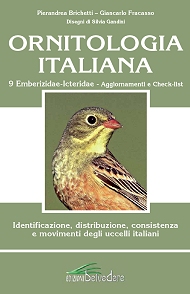
Ornitologia Italiana
Pierandrea Brichetti & Giancarlo Fracasso
2015, 398+XVIII pagine, fotografie a colori, disegni a colori e in bianco & nero
Edizioni Belvedere
Il volume IX di Ornitologia Italiana è finalmente disponibile. Il volume è particolarmente interessante in quanto, oltre ad ospitare le specie delle famiglie Emberizidae - Icteridae, contiene gli aggiornamenti dei volumi precedenti e una serie di liste finali di riferimento: una check-list nazionale con i termini fenologici tradizionali, una lista delle sottospecie italiane e uno schema dell'evoluzione della sequenza delle famiglie nel corso del XX e XXI secolo.
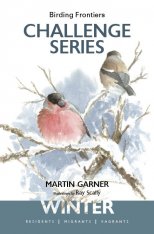 |
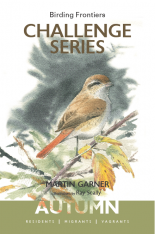 |
Birding Frontiers Challenge Series. Vols. 1 (Autumn) & 2 (Winter)
di Martin Garner (autore) & Ray Scally (illustratore)
Vol 1 Autumn. 2014, 132 pages, colour photos, colour & b/w illustrations, colour distribution maps
Vol 2 Winter. 2015, 132 pages, colour photos, colour & b/w illustrations, colour distribution maps
Birding Frontiers
These are the first two volumes in the series focusing on the seasons of Autumn and Winter. Most birders go out into the field knowing roughly what might be encountered in a given season and not needing all the information on all species pertaining to the whole year. So the Challenge Series begins with a number of Autumn and Winter 'challenges'. Over 40 taxa are covered in 18 chapters ranging from Hen and Northern Harriers, Wilson's and Common Snipe, Pallid and Common Swift, and Siberian and Common Chiffchaff, to potential vagrants like Sharp-shinned Hawk and Yellow-streaked Warbler. There are the new splits such as Cabot's and Sandwich Tern, three Subalpine Warblers, three Lesser Whitethroats and three Stonechat taxa. Each ID challenge is presented in a concise and accessible form with accompanying photos, illustrations, and sonograms where appropriate.
An introductory section explain the genesis and concept of this series of books. The idea is to produce a series of books at the cutting edge of identification discoveries. Some of the material is new and relatively untested. A challenge is laid down to readers. Go out and test these ideas. Watch birds closely and more carefully and make your own discoveries.
The author is acutely aware that people have different learning styles. Not everyone reads books with the same ease and enthusiasm. Besides presenting pithy, easily followed displays of relevant information the author wanted the option to offer video tutorials, sound files, more photos and updates. QR codes answered that desire. With the proliferation of tablets and smart phones, much more material pertinent to each chapter plus fresh discoveries will be available on dedicated web space via the QR codes at the start of each chapter.
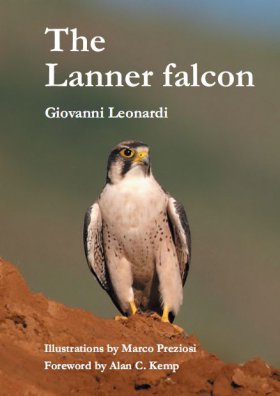
The Lanner Falcon
Giovanni Leonardi
2015, 331 pages, 32 tavole con 52 fotografie e disegni a acolori; numerose foto e illustrazioni in bianco & nero
Giovanni Leonardi Publisher
The Lanner Falcon (Falco biarmicus) has always been viewed as an "oddity", and even the name has a contorted history, with both common and scientific names being subject to debate. Its very existence as a separate Species has also been called into question and even today, as has been the case in the past, much has been written with regard to the identification of the species, its elusive behaviour, and its relationship with its main competitor, the Peregrine Falcon.
Although a first edition of this book was written in 1992, and a subsequent full review written in 2001, the author realized that many aspects of the biology of this falcon still remain virtually unknown. Even today this remains the biggest challenge for future research. Nevertheless, there is an enormous amount of information scattered across a myriad of publications which can add a great deal to our current knowledge of the species.
The author therefore decided to collect together all of the available information in the hope of creating an overview of all that is currently known about the Lanner falcon. In compiling this information he has also referred to numerous sources originally published in the nineteenth century, as well those published more recentiy in the twentieth century. This has proven to be very helpful in understanding many of the anomalies that have been inherited from the past, many of which remain with us today.
For these reasons, this monograph is not simply review of Lanner falcon biology from the many studies that have been published. It is also an attempt to create a new overview of the species that can hopefully serve as a starting point for future research.With this book, at last, everything that is known about the Lanner falcon has been assembled in one place. The ten chapters cover the History, taxonomy and genetics; Structure and functions; Distribution and population estimates; Territory and breeding densities; Breeding seasons; Diet and hunting techniques; Movements; Conservation; and finally, a landscape-scale approach to the habitat associations of tiie members of the large-falcon (or Hierofalco) complex. The coverage ranges back in time to prehistoric fossils that occur outside the presentiy known range of the species, and forward to the possible options and plans for conservation of the species into the future. In between, in information-packed chapters, images and diagrams, every known detail about the species is presented in as much detail as space allows, supported by as many extracts of published and personal communications as the author could discover. The bibliography alone will make this compendium a standard reference for decades to come.
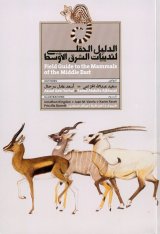
Field Guide to the Mammals of the Middle East (English / Arabic)
Assad Adel Serhal & Saeed Abdulla Alkhuzai (autori); Jonathan Kingdon, Juan M Varela, Karim Farah & Priscilla Barrett (illustratori)
2015, 310 pages, 500+ colour & b/w illustrations
Dr. Saeed Abdulla Alkhuzai Publisher
This guide covers all 200 terrestrial and marine mammals found in the Middle East, particularly in Arabic-speaking countries, where land is surrounded by many bodies of water including the Mediterranean Sea, the Red Sea, the Arabian Sea, the Gulf of Oman and the Arabian Gulf. The authors also tried to cover all habitats including sea, coast, forest, mountains, valleys, deserts, and marshes. To reach a wider audience, the text is both in Arabic and English. This guide is not limited to just being the first of its kind in terms of form, content, its scientific approach and coverage of all mammals of the region, but it is also characterized by the ease and clarity of its information and the ability to identify the animals in the wilderness from their physical description, measurements, favourite habitat, behaviour, breeding, food, etc. It also includes coloured plates and illustrations of each of these species, subspecies, breeds, skulls and footprint when it is available.
The book includes more than 500 coloured illustrations of all animals, including their adult forms, adolescent forms, baby forms, and different genders, as well as renderings of skeletons, tracks and excrement to make their identification in their natural habitat, including images from the private collection of Steven Ramsey, Jonathan Kingdon's famous Mammals of Arabia artwork, work from the Spanish artist Juan Varela, the latest artwork used in Handbook of Mammals of the World, plates of rodents and bats from Harper Collins's Mammals of Britain and Europe, and especially commissioned artwork from the Lebanese artist Karim Farah, who provided a collection of drawings for the movements of some animals.
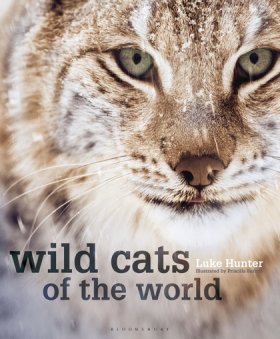
Wild Cats of the World
Luke Hunter (autore), Priscilla Barrett (illustratore)
2015, 240 pages, 400 colour photos, colour & b/w illustrations and colour distribution maps
Bloomsbury Publishing
Ranging from the largest – the Tiger to the smallest species – the Rusty-Spotted Cat and Black-Footed Cat, the world's wild cats are some of the most beautiful, ferocious and feared carnivores in the world. Wild Cats of the World provides a detailed account of each species of wild cat, examining their importance throughout history and the future of some of the most endangered breeds.
Using stunning photography and magnificent colour plates by top wildlife artist Priscilla Barrett to depict each cat in detail, Wild Cats of the World examines the characteristics of all 38 species, as well as their history, distribution and current IUCN status.
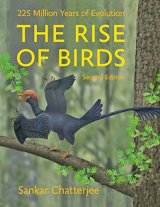
The Rise of Birds: 225 Million Years of Evolution
Sankar Chatterjee (autore)
2015, 370 pages, 1 b/w photo, 161 b/w illustrations
A small set of fossilized bones discovered almost thirty years ago led paleontologist Sankar Chatterjee on a lifelong quest to understand their place in our understanding of the history of life. They were clearly the bones of something unusual, a bird-like creature that lived long, long ago in the age of dinosaurs. He called it Protoavis, and the animal that owned these bones quickly became a contender for the title of "oldest known bird." In 1997, Chatterjee published his findings in the first edition of The Rise of Birds.
Since then Chatterjee and his colleagues have searched the world for more transitional bird fossils. And they have found them. This second edition of The Rise of Birds brings together a treasure trove of fossils that tell us far more about the evolution of birds than we once dreamed possible. With no blind allegiance to what he once thought he knew, Chatterjee devours the new evidence and lays out the most compelling version of the birth and evolution of the avian form ever attempted. He takes us from Texas to Spain, China, Mongolia, Madagascar, Australia, Antarctica, and Argentina. He shows how, in the "Cretaceous Pompeii" of China, he was able to reconstruct the origin and evolution of flight of early birds from the feathered dinosaurs that lay among thousands of other amazing fossils.
Chatterjee takes us to where long-hidden bird fossils dwell. His compelling, occasionally controversial, revelations – accompanied by spectacular illustrations – are a must-read for anyone with a serious interest in the evolution of "the feathered dinosaurs," from vertebrate paleontologists and ornithologists to naturalists and birders.
Chiudi il box
